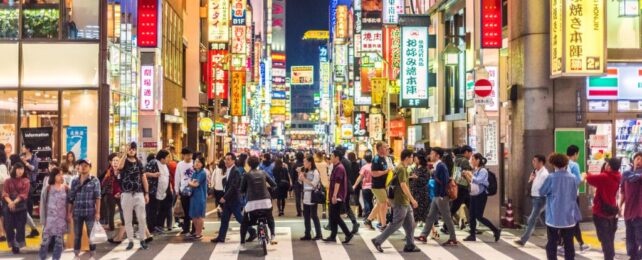The genes of modern Japanese people may have been hiding a long-lost line of ancestors, who once migrated to the top of the archipelago from the northeastern mainland of Asia.
The discovery supports emerging evidence, which suggests that modern Japanese people are descended from not two but three ancestral lineages.
Until recently, the dominating hypothesis was that Japan's population was formed through the mixing of two groups of ancestors: the Indigenous Jōmon people – who arrived in Japan from ancient East Asia more than 10,000 years ago – and the rice-farming people from northeast Asia – who migrated from the continental mainland starting around 2,300 years ago.
In 2021, however, a genetic study detected a third wave of migrants for the first time, initiating a competing origin story.
Geneticist Chikashi Terao, senior author of the newest analysis, says he and his colleagues have revealed Japan's "subpopulation structure on a fine scale". Their results are "beautifully classified" across seven regions, running the length of the nation.
Sequencing the DNA of more than 3,200 people from these locations, Terao and his team have produced what they claim is one of the largest genetic analyses of a non-European population to date. It reveals insights into the population's genetic structure that could have potential for personalized medicine.
"We reasoned that rare variants can sometimes be traced back to specific ancestral populations, and could be informative in revealing fine-scale migration patterns within Japan," explains Terao, who works at the RIKEN Center.
Comparing modern and ancient genetic data, the team used both common and rare variants to identify three main clusters of ancestry within most of Japan's population.
The results suggest that today, Jomon ancestry is most dominant in the south of Japan. Meanwhile, people in the west of Japan are more closely related to Han Chinese, who continued to migrate from the East Asian continental mainland until about 800 CE.
People in northeastern Japan, however, have a different dominant ancestry. The genetic makeup of this population is less clear, the team says, though it may be explained by a two-way mixing of Korean ancestry and Han Chinese ancestry.
Historical records suggest the northeast region was once inhabited by yet another old lineage, the Emishi people, in the fifth century CE. This name literally translates to "shrimp barbarians", and while no one really knows where the Emishi came from, it has been suggested that they are descended from people that lived on what is now the Korean peninsula.
The study also helped identify the likely roots of two genes linked to inherited breast cancer in Japanese people. For example, a BRCA1 mutation specific to the Japanese population with a significantly higher frequency in eastern Japan, appears to have originated in people with northeastern Japanese ancestry and spread to other regions of the country.
"This comprehensive genetic dataset enables us to delve into uncharted territories concerning population and medical genetics of the Japanese population," write the authors of the genetic analysis.
Ancient genome samples are hard to come by, which limits our ability to compare genetic quirks seen in people today to those of the past. As many as 40 percent of the genetic variants identified by researchers in the current study were unregistered.
Terao and his colleagues caution uncertainty still persists in their data, though their findings match the 'tripartite' origin hypothesis across most regions of Japan.
Nevertheless, emerging evidence suggests that the makeup of Japan's population is more complex than scientists originally thought. To better understand human history and health, including diverse populations in genetic research is important.
The study was published in Science Advances.
